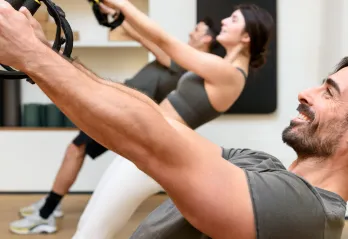Why Unilateral Training is a Game-Changer for Strength and Balance

What is Unilateral Training?
If you've ever done a lunge, step-up, or single-arm press, you've already practiced unilateral training. Unlike traditional exercises that use both sides of the body
equally (bilateral movements like squats and bench presses), unilateral training focuses on one side at a time. A popular example is the kickstand deadlift, where
one foot is slightly behind the other for support while the front leg does most of the work.
Why is Unilateral Training Important?
Many people focus on bilateral exercises, but training one side at a time has unique benefits, especially if you’re looking to improve balance, fix muscle imbalances, and reduce injury risk.
1. Fixes Muscle Imbalances
Most people have a stronger side—whether it’s their right or left leg, or one arm being more dominant. Bilateral exercises often allow the stronger side to
compensate for the weaker one, leading to imbalances that can cause pain or injury.
Example: If your left leg is weaker than your right, a barbell squat might not
expose the difference, but a single-leg squat or kickstand exercise will highlight it, helping you address the weakness.
2. Boosts Balance and Stability
Balance is crucial for everyday activities like walking, climbing stairs, and avoiding falls. Unilateral training forces your stabilizer muscles to work harder, improving
coordination and body control.
Example: Older adults or athletes recovering from injury benefit greatly from unilateral work because it strengthens stabilizing muscles, making movements smoother and more controlled.
3. Enhances Core Strength
Because unilateral exercises create an uneven load, your core has to engage more to keep your body stable. This means a stronger midsection, which translates to better posture and lower back health.
Example: A single-arm shoulder press forces your abs and obliques to work harder to keep your torso upright compared to using both arms.
4. Reduces Injury Risk
Unilateral movements highlight weak links in your body, allowing you to strengthen them before they become a problem. This can help prevent injuries, especially in
sports or daily activities that require sudden movements or directional changes.
Example: Runners benefit from unilateral leg training since running is a single-leg activity. Strengthening each leg individually improves performance and reduces overuse injuries.
How to Incorporate Unilateral Training
Adding unilateral exercises to your routine doesn’t mean replacing all bilateral movements. Instead, use them to complement your workouts for a balanced approach.
Beginner-Friendly Unilateral Exercises
- Kickstand Deadlifts – Great for improving hamstring and glute strength while keeping balance support.
- Single-Leg Squats (to a Box) – Helps build leg strength while reducing stress on the knees.
- Step-Ups – Mimics real-life movements like climbing stairs while building strength.
- Single-Arm Rows – Improves back and core strength while fixing muscle imbalances.
- Bulgarian Split Squats – A challenging exercise that builds strength, stability, and flexibility.
Common Mistakes to Avoid
- Using Too Much Weight Too Soon – Start light and focus on control to avoid straining stabilizing muscles.
- Neglecting the Weaker Side – Always do the same number of reps on both sides to balance strength.
- Rushing Through Reps – Move slowly and with control to fully engage muscles and prevent injury.
How the YMCA Can Help
Not sure where to start? The YMCA’s personal training programs can help you integrate unilateral training safely and effectively.
Our certified trainers can:
- Assess your muscle imbalances
- Design a program tailored to your needs
- Teach proper form to prevent injuries
Take the First Step Today!
Author
